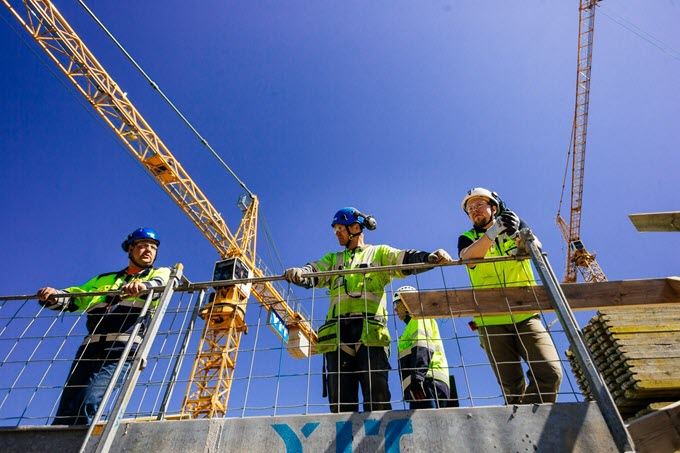Sustainable data centers as a service
- Construction
- Sustainability
- 9/21/2021
The world’s first apartment building built with low-carbon hollow-core slabs is under construction in Vantaa’s Lentola district
Consolis Parma developed a new hollow-core slab at the initiative of YIT, which published its emission targets in 2019.

Asunto Oy Vantaan Mekaanikko, an apartment building under construction in Vantaa’s Lentola district, features intermediate floors built entirely using Parma’s low-carbon hollow-core slabs. It is YIT’s – and the world’s – first apartment building of its kind.
There is an interesting story behind the creation of the low-carbon hollow-core slabs. It starts in 2019, when YIT announced its emission targets aimed at halving the emissions of YIT’s own operations and self-developed projects by 2030.
“When the targets were published, the Housing segment immediately began to seek solutions for achieving the targets,” says Procurement Manager Mika Toivonen. “We used an example building to analyse the actual sources of emissions of our apartment buildings. The example building is a hypothetical building that illustrates YIT’s average housing production.
“We learned that hollow-core slabs are the most significant individual product with regard to emissions.” The emission calculations for the index building were carried out by Tatu Tikkanen in his thesis written for Tampere University.
When the emissions associated with hollow-core slabs had been recognised, Toivonen contacted Parma, a company that YIT’s Housing segment had a long history of joint development with.
“Parma was excited about the idea of a low-carbon hollow-core slab and their product development function got started on it right away. The people at Parma deserve a great deal of credit for that! The hollow-core slab is an excellent product for investigating low-carbon solutions because, in addition to being a high-volume product, it is a simple product with which a major impact can be achieved through product development.”
After the initial impulse, the main responsibility for joint development meetings and commercialisation was taken on by YIT’s Lassi Hämäläinen along with Parma’s Juha Rämö and Satu Parikka.
A significant reduction in emissions
Simplifying matters slightly, it could be said that YIT’s emission targets led to the creation of Parma’s low-carbon hollow-core slabs – a view that is echoed by Technology Director Juha Rämö, the person in charge of sustainability at Parma.
“Indeed, YIT was a great sparring partner for us in this development project. Parma had already decided to start developing low-carbon concrete construction solutions with a tangible approach, and we decided to choose hollow-core slabs as the first product due to their high impact. It was also very useful to have access to YIT’s emission data to support our development efforts,” Rämö says.
Parma developed its formula for low-carbon hollow-core slabs in record time – it only took about three months. The company made use of the Consolis Group’s research and testing data in the development effort. YIT participated in the product development process by establishing a working group consisting of representatives from various teams at YIT.
The process had a successful outcome, as the new hollow-core slabs were calculated to be approximately 40% lower in carbon than their predecessors.
“This is a significant figure,” Toivonen points out. “In practice, it means that a YIT property built entirely using low-carbon hollow-core slabs will have a 6–7% reduction in emissions.”
The product development process was followed by test casting and various other tests. Everything looked promising, so YIT decided to carry out a pilot project using the new product.
“In the pilot project in Espoo’s Perkkaa district in Vermo, we only used a small number of hollow-core slabs to enable us to study how they perform compared to the adjacent standard slabs. We studied creep, installability and the adhesion of screed, for example. The outcome of the pilot was that everything went well and the product was excellent,” Toivonen explains.
The significance of sustainability will only grow in the near future
After the small-scale pilot, it was time for a larger pilot project, which brings us back to Asunto Oy Vantaan Mekaanikko.
“Low-carbon hollow-core slabs are still slightly more expensive than standard slabs. However, many of the investors we work with have emission targets of their own, which is why they are prepared to invest in low-carbon solutions. Fortunately, we were able to offer such a solution,” Toivonen says.
“Sustainability emerged as an important requirement in the business premises segment over a decade ago and it is now the default assumption. The same trend is only starting in the residential property segment, but it will be a quick process,” says Patrick Gylling, CEO of Oy Sirius Capital Partners Ab, the investor behind the Mekaanikko project. “We believe that, in the near future, nothing will be built without addressing sustainability and green construction. This is why we see initiatives such as low-carbon hollow-core slabs as worthwhile investments.
“Parma will continue to actively develop climate-friendly concrete construction. The range of low-carbon products based on PARMA Green technology will be expanded to include all product categories and their emission impacts will be indicated by Environmental Product Declarations,” Juha Rämö explains.
“Circular economy is a significant element of our strategy alongside the low-carbon approach. In accordance with our PARMA Concrete Care sustainability programme, our goal is to reduce our emissions by 5% annually and to use all material waste as raw material for new products,” Rämö concludes.
“YIT wants to be a developer of future-proof urban environments. In order for us to continue to enjoy a stable operating environment, sufficient natural resources, satisfied employees and delighted customers in the future, we must take sustainability into consideration in our operations, our products and our services. We cannot accomplish this alone, but there is strength in cooperation with our customers and partners,” Toivonen says.



